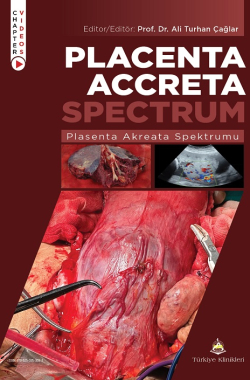Transfusion of Blood and Blood Products
Dr. Recep Taha Ağaoğlu1
Assoc. Prof. Dr. Ahmet Şeyhanlı2
1Department of Perinatology, Ankara Etlik City Hospital, Ankara, Türkiye
2Department of Hematology, Gazi University Faculty of Medicine, Ankara, Türkiye
ABSTRACT
Placenta accreta spectrum (PAS) is one of the obstetric emergencies and a leading cause of maternal mor- bidity and mortality. PAS is characterized by an abnormal invasion of the placenta into the myometrium and can lead to life-threatening blood loss during delivery. Therefore, an accurate assessment of the amount of bleeding and the determination of appropriate transfusion strategies are crucial in the management of PAS. In PAS cases, blood loss during surgery is usually higher than expected, and massive blood transfusions can often occur, especially in emergency surgery. In blood transfusion management, the use of red blood cell suspensions, platelet and plasma products in appropriate proportions is crucial to ensuring hemostasis. In addition, monitoring of fibrinogen levels and replacement with fibrinogen concentrate or cryoprecipitate, if necessary, are important to control potential coagulopathy. Effective implementation of massive transfusion protocols and adjustment of the transfusion rate to the patient’s hemodynamic status will help improve mater- nal outcomes. In the treatment of PAS, correction of anemia in the preoperative phase, minimization of blood loss during surgery, and monitoring of potential complications in the postoperative phase require a multidisci- plinary approach. In this context, tailoring a treatment plan according to the individual characteristics of each patient is crucial to optimizing maternal and fetal outcomes.
Keywords: Placenta accreta spectrum; Blood component transfusion; Maternal mortality
Kaynak Göster
Referanslar
- Al Kadri HMF, Al Anazi BK, Tamim HM. Visual estima- tion versus gravimetric measurement of postpartum blood loss: a prospective cohort study. Arch Gynecol Obstet. 2011;283(6):1207-1213. [Crossref] [PubMed]
- Committee on Practice Bulletins-Obstetrics. Prac- tice Bulletin No. 183: Postpartum Hemorrhage. Obstet Gynecol. 2017;130(4):e168-e186. [Crossref] [PubMed]
- Wright JD, Pri-Paz S, Herzog TJ, Shah M, Bonanno C, Lewin SN, et al. Predictors of massive blood loss in women with placenta accreta. Am J Obstet Gynecol. 2011;205(1):38. e1-6. [Crossref] [PubMed]
- Miller SE, Leonard SA, Meza PK, Ku S, Ren LY, Lyell DJ, et al. Red Blood Cell Transfusion in Patients With Placen- ta Accreta Spectrum: A Systematic Review and Meta-anal- ysis. Obstet Gynecol. 2023;141(1):49-58. [Crossref] [PubMed]
- Petersen LA, Lindner DS, Kleiber CM, Zimmerman MB, Hinton AT, Yankowitz J. Factors that predict low he- matocrit levels in the postpartum patient after vaginal delivery. Am J Obstet Gynecol. 2002;186(4):737-744. [Crossref] [PubMed]
- Bose P, Regan F, Paterson-Brown S. Improving the accuracy of estimated blood loss at obstetric haemorrhage using clinical re- constructions. BJOG Int J Obstet Gynaecol. 2006;113(8):919- 924. [Crossref] [PubMed]
- Coviello E, Iqbal S, Kawakita T, Chornock R, Cheney M, Desale S, et al. Effect of Implementing Quantitative Blood Loss Assessment at the Time of Delivery. Am J Perina- tol. 2019;36(13):1332-1336. [Crossref]
- Collins SL, Alemdar B, van Beekhuizen HJ, Bertholdt C, Braun T, Calda P, et al. Evidence-based guidelines for the management of abnormally invasive placenta: recommen- dations from the International Society for Abnormally Inva- sive Placenta. Am J Obstet Gynecol. 2019;220(6):511-526. [Crossref]
- Kahr MK, Brun R, Zimmermann R, Franke D, HaslingerC. Validation of a quantitative system for real-time mea- surement of postpartum blood loss. Arch Gynecol Obstet. 2018;298(6):1071-1077. [Crossref]
- Brecher ME, Monk T, Goodnough LT. A standard- ized method for calculating blood loss. Transfusion (Paris). 1997;37(10):1070-1074. [Crossref]
- Butwick AJ, McDonnell N. Antepartum and postpartum ane- mia: a narrative review. Int J Obstet Anesth. 2021;47:102985. [Crossref]
- Overview | Antenatal care | Guidance | NICE. August 19, 2021. Accessed July 11, 2024. [Link]
- Breymann C, Honegger C, Hösli I, Surbek D. Diagnosis and treatment of iron-deficiency anaemia in pregnancy and postpartum. Arch Gynecol Obstet. 2017;296(6):1229-1234. [Crossref]
- Niepraschk-von Dollen K, Bamberg C, Henkelmann A, Mickley L, Kaufner L, Henrich W, et al. Predelivery ma- ternal fibrinogen as a predictor of blood loss after vagi- nal delivery. Arch Gynecol Obstet. 2016;294(4):745-751. [Crossref]
- Bienstock JL, Eke AC, Hueppchen NA. Postpartum Hemor- rhage. N Engl J Med. 2021;384(17):1635-1645. [Crossref]
- Hofer S, Blaha J, Collins PW, Ducloy-Bouthors AS, Guasch E, Labate F, et al. Haemostatic support in postpartum hae- morrhage: A review of the literature and expert opin- ion. Eur J Anaesthesiol. 2023;40(1):29-38. [Crossref] [PubMed]
- Escobar MF, Nassar AH, Theron G, Barnea ER, Nicholson W, Ramasauskaite D, et al. FIGO recommendations on the man- agement of postpartum hemorrhage 2022. Int J Gynaecol Ob- stet. 2022;157 Suppl 1(Suppl 1):3-50. [Crossref] [PubMed]
- Kaufman RM, Djulbegovic B, Gernsheimer T, Klein- man S, Tinmouth AT, Capocelli KE, et al. Platelet trans- fusion: a clinical practice guideline from the AABB. Ann Intern Med. 2015;162(3):205-213. [Crossref] [PubMed]
- Muñoz M, Stensballe J, Ducloy-Bouthors AS, Bonnet MP, De Robertis E, Fornet I, et al. Patient blood management in obstetrics: prevention and treatment of postpartum hae- morrhage. A NATA consensus statement. Blood Transfus. 2019;17(2):112-136. [Crossref] [PubMed]
- Collins P, Abdul-Kadir R, Thachil J, Subcommittees on Women' s Health Issues in Thrombosis and Haemostasis and on Disseminated Intravascular Coagulation. Management of coagulopathy associated with postpartum hemorrhage: guidance from the SSC of the ISTH. J Thromb Haemost. 2016;14(1):205-210. [Crossref] [PubMed]
- Wang L, Matsunaga S, Mikami Y, Takai Y, Terui K, Seki H. Pre-delivery fibrinogen predicts adverse maternal or neona- tal outcomes in patients with placental abruption. J Obstet Gynaecol Res. 2016;42(7):796-802. [Crossref] [PubMed]
- Atallah A, Piccin G, Dubernard G, Abdul-Hay MJ, Cortet M, Huissoud C. Fibrinogen for the prediction of severe maternal complications in placental abruption with fetal death after 24 weeks of gestation. Int J Gynaecol Obstet. 2023;160(3):900- 905. [Crossref] [PubMed]
- Carson JL, Guyatt G, Heddle NM, Grossman BJ, Cohn CS, Fung MK, et al. Clinical Practice Guidelines From the AABB: Red Blood Cell Transfusion Thresholds and Storage. JAMA. 2016;316(19):2025-2035. [Crossref] [PubMed]
- Góes EG, Borges JC, Covas DT, Orellana MD, Palma PVB, Morais FR, et al. Quality control of blood irradia- tion: determination T cells radiosensitivity to cobalt-60 gamma rays. Transfusion. 2006;46(1):34-40. [Crossref] [PubMed]
- Roback JD, Caldwell S, Carson J, Davenport R, Drew MJ, Eder A, et al. Evidence-based practice guidelines for plasma transfusion. Transfusion. 2010;50(6):1227-1239. [Crossref] [PubMed]
- Stanworth SJ, Brunskill SJ, Hyde CJ, McClelland DBL, Murphy MF. Is fresh frozen plasma clinically effec- tive? A systematic review of randomized controlled tri- als. Br J Haematol. 2004;126(1):139-152. [Crossref] [PubMed]
- Nascimento B, Goodnough LT, Levy JH. Cryoprecipitate therapy. Br J Anaesth. 2014;113(6):922-934. [Crossref] [PubMed]
- Rossaint R, Bouillon B, Cerny V, Coats TJ, Duranteau J, Fernández-Mondéjar E, et al. The European guideline on management of major bleeding and coagulopathy fol- lowing trauma: fourth edition. Crit Care. 2016;20:100. [Crossref] [PubMed]
- Pieters M, Wolberg AS. Fibrinogen and fibrin: An illus- trated review. Res Pract Thromb Haemost. 2019;3(2):161-172. [Crossref] [PubMed]
- Ghadimi K, Levy JH, Welsby IJ. Prothrombin Com- plex Concentrates for Bleeding in the Perioperative Set- ting. Anesth Analg. 2016;122(5):1287-1300. [Crossref] [PubMed]
- Murakami M, Kobayashi T, Kubo T, Hata T, Takeda S, Ma- suzaki H. Experience with recombinant activated factor VII for severe post-partum hemorrhage in Japan, investigated by Perinatology Committee, Japan Society of Obstetrics and Gynecology. J Obstet Gynaecol Res. 2015;41(8):1161- 1168. [Crossref] [PubMed]
- AlGahtani FH, Alshaikh M, AlDiab A. Recombinant ac- tivated factor VII in controlling bleeding in non-hemo- philiac patients. Ann Saudi Med. 2010;30(3):198-202. [Crossref] [PMC]
- Levi M, Levy JH, Andersen HF, Truloff D. Safety of recom- binant activated factor VII in randomized clinical trials. N Engl J Med. 2010;363(19):1791-1800. [Crossref] [PubMed]
- Ruggeri ZM. Structure and function of von Willebrand fac- tor: relationship to von Willebrand's disease. Mayo Clin Proc. 1991;66(8):847-861. [Crossref] [PubMed]
- Monahan PE, Di Paola J. Recombinant factor IX for clinical and research use. Semin Thromb Hemost. 2010;36(5):498-509. [Crossref] [PubMed]
- Dalakas MC. Intravenous immunoglobulin in autoimmune neuromuscular diseases. JAMA. 2004;291(19):2367-2375. [Crossref] [PubMed]
- Khayat CD, Lohade S, Zekavat OR, Kruzhkova I, Solomon C, Peyvandi F. Efficacy and safety of fibrinogen concentrate for perioperative prophylaxis of bleeding in adult, adolescent, and pediatric patients with congenital fibrinogen deficiency: FORMA-02 and FORMA-04 clinical trials. Transfusion (Paris). 2022;62(9):1871-1881. [Crossref] [PubMed]
- Lin VS, Sun E, Yau S, Abeyakoon C, Seamer G, Bhopal S, et al. Definitions of massive transfusion in adults with crit- ical bleeding: a systematic review. Crit Care Lond Engl. 2023;27(1):265. [Crossref] [PubMed]
- Cunningham FG, Nelson DB. Disseminated Intra- vascular Coagulation Syndromes in Obstetrics. Ob- stet Gynecol. 2015;126(5):999-1011. [Crossref] [PubMed]
- Rahouma M, Kamel M, Jodeh D, Kelley T, Ohmes LB, de Biasi AR, et al. Does a balanced transfusion ratio of plasma to packed red blood cells improve outcomes in both trauma and surgical patients? A meta-analysis of randomized controlled trials and observational studies. Am J Surg. 2018;216(2):342-350. [Crossref] [PubMed]
- Carvajal JA, Ramos I, Kusanovic JP, Escobar MF. Dam- age-control resuscitation in obstetrics. J Matern-Fetal Neo- natal Med Off J Eur Assoc Perinat Med Fed Asia Ocean Peri- nat Soc Int Soc Perinat Obstet. 2022;35(4):785-798. [Crossref] [PubMed]
- YANG JC, SUN Y, XU CX, DANG QL, LI L, XU YG,et al. Coagulation defects associated with massive blood transfusion: A large multicenter study. Mol Med Rep. 2015;12(3):4179-4186. [Crossref] [PMC]
- Meng ZH, Wolberg AS, Monroe DM, Hoffman M. The effect of temperature and pH on the activity of factor VIIa: impli- cations for the efficacy of high-dose factor VIIa in hypother- mic and acidotic patients. J Trauma. 2003;55(5):886-891. [Crossref] [PubMed]
- Dzik WH, Kirkley SA. Citrate toxicity during massive blood transfusion. Transfus Med Rev. 1988;2(2):76-94. [Crossref] [PubMed]
- British Committee for Standards in Haematology, Stains- by D, MacLennan S, Thomas D, Isaac J, Hamilton PJ. Guidelines on the management of massive blood loss. Br J Haematol. 2006;135(5):634-641. [Crossref] [PubMed]
- Chanthima P, Yuwapattanawong K, Thamjamrassri T, Nathwani R, Stansbury LG, Vavilala MS, et al. Association Between Ionized Calcium Concentrations During Hemo- static Transfusion and Calcium Treatment With Mortality in Major Trauma. Anesth Analg. 2021;132(6):1684-1691. [Crossref] [PubMed]
- Refaai MA, Blumberg N. The transfusion dilemma--weigh- ing the known and newly proposed risks of blood transfusions against the uncertain benefits. Best Pract Res Clin Anaesthesi- ol. 2013;27(1):17-35. [Crossref] [PubMed]
- Szczepiorkowski ZM, Dunbar NM. Transfusion guidelines: when to transfuse. Hematol Am Soc Hematol Educ Program. 2013;2013:638-644. [Crossref] [PubMed]
- Vamvakas EC, Blajchman MA. Transfusion-related mortality: the ongoing risks of allogeneic blood transfusion and the avail- able strategies for their prevention. Blood. 2009;113(15):3406- 3417. [Crossref] [PubMed]
- Benson AE, Shatzel JJ, Ryan KS, Hedges MA, Mar- tens K, Aslan JE, et al. The incidence, complications, and treatment of iron deficiency in pregnancy. Eur J Haema- tol. 2022;109(6):633-642. [Crossref] [PubMed]


